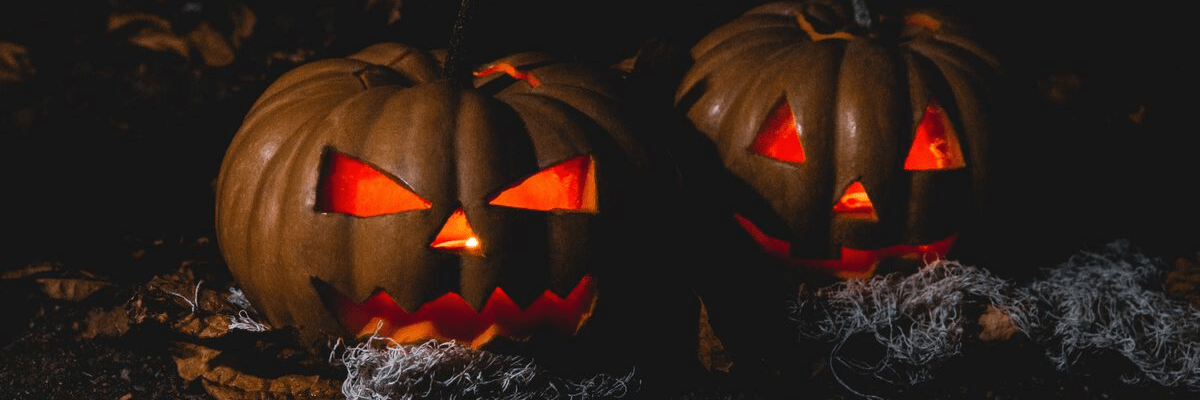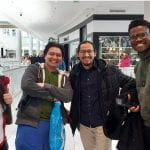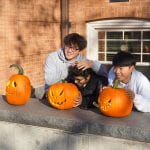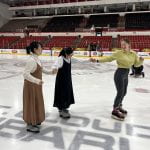Halloween in the U.S.

By: Paripa Michelle Ganou
“When witches go riding and black cats are seen the moon laughs and whispers, ‘tis near Halloween.” ~ Author Unknown
Have you ever celebrated Halloween? It’s a well-known holiday, but not every country or culture celebrates it. In the U.S., it is one of the most popular holidays, with many traditions and festivities. This is a great experience for international students that want to learn more about American Culture. In this post, we’re going to tell you everything you need to know about your first Halloween in America.
The History
Halloween takes it origins from the Celtic festival known as Samhain (pronounced sow-in) nearly 2,000 years ago in the area of modern day Ireland/UK. This festival was celebrated November 1.It marked the end of the harvest and the beginning of winter. The cold, dark winters reminded them of death, and so the holiday came to represent the boundary between the two words: the living and the dead. In fact, they believed that the dead could walk among the living during this time of year. The religious leaders would light bonfires—huge fires—and dress up in costumes to scare away evil spirits.

Bonfire
The Roman Empire then took over the area. Their influence and religion changed the Samhain festival, bringing new traditions and symbols. The Christian church created two new holidays. All Saint’s Day, November 1, honored Christian Martyrs, and All Soul’s Day, November 2, honored all of the dead. The church was trying to replace the old pagan traditions of the Celts. Celebrations were similar to Samhain with bonfires, parades, and costumes. All Saint’s Day became known “All-Hallowmas” and the day before it became “All-Hallows Eve”—eventually Halloween, October 31.
Halloween came to America during colonial times. Because of the mixing of different cultures, Halloween started to have its own American traditions. Most traditional activities started early on—celebrating the harvest, ghost stories, playing pranks, and parties. In the 1800s, more Irish came to America, which helped the holiday to grow even more popular. People would dress up in costumes, as they did in Europe, and go door to door asking for food or money. As time went on, Halloween lost a lot of its religious meaning and became a more commercial holiday focused on “scary” characters, jack-o-lanterns, candy, and fun.
Did you know that Minnesota has the Halloween Capital of the World? Anoka, Minnesota was the first city in America to hold an official Halloween celebration. The idea started in 1920. It was to stop children from being mischievous on the holiday. The townspeople organized a parade and spent weeks planning and making costumes. The community came together. They had a bonfire and gave treats including popcorn, candy, and peanuts to children who marched in the parade. Anoka continues to have one of the best Halloween parties in the world.
Symbols of Halloween
Halloween has a ton of signs and symbols associated with it. Can you think of any you have seen? Here are a few common ones:

Graveyard
- Scary characters like witches, vampires, werewolves, demons and goblins. These are often popular Halloween costumes.
- Ghosts and skeletons represent the dead and are also used as Halloween costumes
- Bats, spiders, and black cats are often decorations for Halloween parties because people fear them. Black cats bring bad luck.
- Orange and black. These colors are associated with Halloween whenever they are together.
- Pumpkins, corn, apples, and wheat. These food items symbolize the harvest.
Modern American Traditions
Costumes
Costumes can be more than just scary characters! While tradition costumes like ghosts, vampires, and witches are great costumes, many people now dress up as their favorite characters from TV shows and movies. Some even wear costumes that are funny, rather than scary. Some people dress up as their favorite food or animal. You can be whatever you want!

Trick-or-Treat
Trick or Treat
Children look forward to this part of Halloween the most. They dress up in their costume and go door-to-door in neighborhoods to ask for treats. When a door opens, the children say, “Trick or Treat!” The homeowner will then place candy or other treat in the children’s bags. The phrase “trick or treat” is a silly saying meaning that if the child does not get a treat, he or she will play a trick on the homeowner.
Candy
Americans will spend close to $2.6 billion on Halloween candy this year. Popular candies are Skittles, Reese’s peanut butter cups, M&Ms, Tootsie Rolls, Hershey’s chocolates, candy corn, and more!
Parties
Halloween parties are a lot of fun, especially if they are a costume party. Dress up in your best costume. Many parties have a competition to see who has the best costume idea, so get creative!
Jack-o-Lanterns or Pumpkin Carving
Halloween is not complete without carving a pumpkin.

Jack-o-Lantern
The Irish brought this tradition to America. Pumpkins actually did not exist in Ireland, so the original Celtic culture carved faces into turnips All Hallows Eve to scare away evil spirits. A carved pumpkin is a “Jack-o-Lantern” because we put a candle into the carved pumpkin to light up the design at night. They decorate the outside of houses for Halloween. An extra tasty treat is made from roasting the pumpkin seeds collected while cleaning out the pumpkin.
Scary Stories & Horror Movies
One thing that has stayed relatively the same is the fear of the dead and all other horror-related things! In the U.S., we watch many scary movies and share ghost stories to celebrate this time of year.
IEC Halloween Party
The Intensive English Center will host a Halloween Party on October 31. It is a great opportunity for IEC students to learn about the traditions we mentioned. We will be carving pumpkins, enjoying treats, playing games, and sharing scary stories. We cannot wait to celebrate the holiday with our students! We even have some scary stories to tell about campus….
Students, check your e-mails for an invitation! You will need to sign up in the IEC office for a pumpkin to carve.















